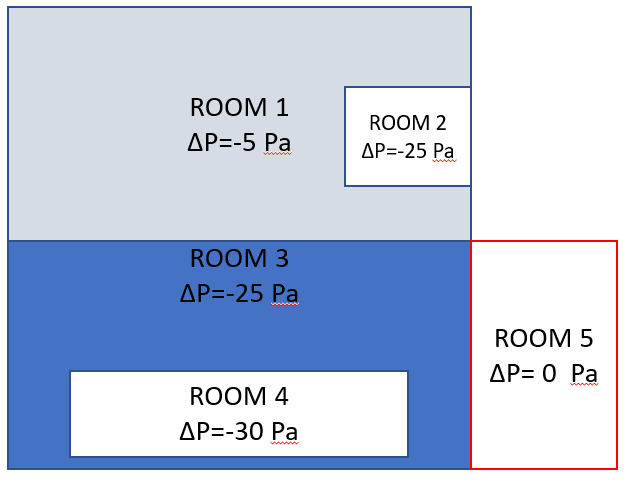Hello to all,
I am a mechanical engineer entering the HVAC world and have stroke upon a case that neither my colleagues nor I can give a clear answer to.
We are designing a building that is compounded by zones with different depressure levels, the building is surrounded by air at atmospheric pressure. We are trying to achieve the depressures in the rooms by maintaining the supply airflow constant and varying the extraction airflow. The depression is achieved by extracting more air than is supplied.
The extraction airflow to achieve the depression is calculated as the sum of the supply air + infiltrations + leakages (Qext = Qsupply + Qinf + Qleak).
The leakages and infiltrations considered are the ones which take place through the doors.
The image attached shows a representation of the distribution of the rooms.

The problem arrives when the extraction airflow is calculated (formula in red) after de calculation of the infiltrations/leakages. It results that in some of the areas, especially the room shaded in grey (room 1), the leakages are greater than the infiltrations and, therefore, the extraction airflow is lower than the supply airflow, creating a contradiction as it would not create a depression.
This can not be like this, but after checking all the calculations it seems that they are right and that the problem is in the concept or the configuration.
What do you think? is there another method to calculate extraction airflow in depressurised areas adjacent to rooms more depressurised?
Thank you in advance!
I am a mechanical engineer entering the HVAC world and have stroke upon a case that neither my colleagues nor I can give a clear answer to.
We are designing a building that is compounded by zones with different depressure levels, the building is surrounded by air at atmospheric pressure. We are trying to achieve the depressures in the rooms by maintaining the supply airflow constant and varying the extraction airflow. The depression is achieved by extracting more air than is supplied.
The extraction airflow to achieve the depression is calculated as the sum of the supply air + infiltrations + leakages (Qext = Qsupply + Qinf + Qleak).
The leakages and infiltrations considered are the ones which take place through the doors.
The image attached shows a representation of the distribution of the rooms.

The problem arrives when the extraction airflow is calculated (formula in red) after de calculation of the infiltrations/leakages. It results that in some of the areas, especially the room shaded in grey (room 1), the leakages are greater than the infiltrations and, therefore, the extraction airflow is lower than the supply airflow, creating a contradiction as it would not create a depression.
This can not be like this, but after checking all the calculations it seems that they are right and that the problem is in the concept or the configuration.
What do you think? is there another method to calculate extraction airflow in depressurised areas adjacent to rooms more depressurised?
Thank you in advance!
